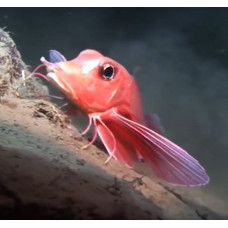Latin name
Trigla lyra
Other name
Piper, lyre gurnard.
Identification
These fish have a large head with numerous spines and ridges, but without a deep occipital groove. There are no scales on the thorax, and the belly is only partially covered with scales. The scales on the lateral line are small and tubular.
Features of fish fins
The first dorsal fin has 8 to 10 spines, the anterior margin of the first dorsal fin awn is smooth. Both the second dorsal and anal fins contain 15 or 16 soft rays each. The caudal fin is slightly concave. The pelvic fins are well developed with a single spine and 5 soft rays. The pectoral fins are even larger, reaching the anterior rays of the second dorsal fin, and the three lower rays are separate, thickened, and finger-like.
Fish colouring
Upper body red, lower body pale. Webs of anal and pectoral fins dark, with small blue spots.
Distribution
Occurs in the eastern Atlantic from Scotland south to Wolf's Bay in Namibia, including the Macaronesian Islands and the Gulf of Guinea Islands, occurs in the Mediterranean Sea but not in the Black Sea.
Habitat
It is a deep-sea bottom fish that inhabits depths down to 700 m (2,300 ft) and prefers sandy and muddy bottoms.
Size
The maximum published total length of this species is 60 cm (24 inches), although a length of 30 cm (12 inches) is more common.
Behavior
When the Piper gurnard is taken out of the water, it makes sounds similar to rumbling.
Food and feeding habits
The diet is dominated by crustaceans, especially pegitic species such as schools of shrimps, and bottom-dwelling species such as crabs and hermit crabs. They also feed on echinoderms, especially starfish, polychaetes, and small bottom-dwelling fish.
Reproduction
Sexual maturity is reached at about 30 centimeters (12 inches) and pelagic eggs are laid during the summer months. The larvae are already protected by bony plates and some spines. These fish can live up to 7 years.
Fishing
In the east-central Atlantic, this fish is not commercially fished or exported, but is caught and consumed locally. And in the Mediterranean, the species is commercially fished and regularly sold in the markets of Morocco, Greece and Turkey, and occasionally elsewhere.
Relationship with a person
Harmless. The meat of this fish is sold fresh or chilled.
Interesting facts
The fan-shaped pectoral fins of the Piper gurnard have three stiff, curved spines. They are used to "walk" on the sea floor.
| Classification | |
| Class | Actinopterygii |
| Squad | Scorpaeniformes |
| Family | Triglidae |
| Genus | Trigla |
| Species | T. lyra |
| Features | |
| Conservation status | Least Concern |
| Habitat | Bottom |
| Life span, years | 7 |
| Maximum body weight, kg | No information |
| Maximum length, cm | 60 |
| Sailing speed, m/s | No information |
| Threat to people | Edible |
| Way of eating | Predator |
Piper gurnard
Tags: piper gurnard


